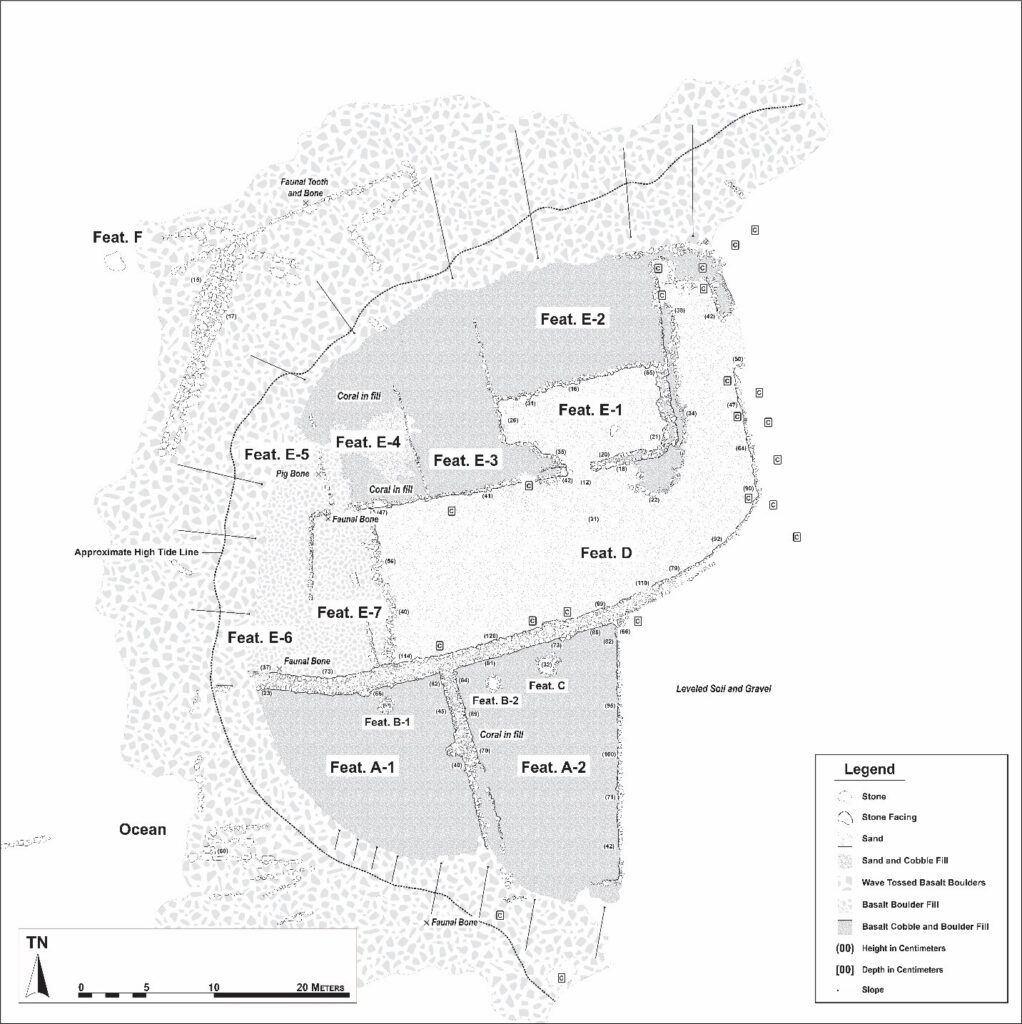“Kona … had three marked areas – Kekaha in the north [from around Honokōhau to Keahualono, the Kona-Kohala Boundary], central Kona, and [Kapalilua] in the south [from Honokua and south to Manukā].” (Cordy)
In Kekaha (a shortened version of Kekaha-wai-‘ole o nā Kona” (waterless Kekaha of the Kona district) in the northern portion of Kona (Maly)) “the lands are increasingly more arid”.
“[T]he central portions [of Kona] had arid shorelines with shallow soil in pockets amidst rocky outcrops and bare lava flows … High rainfall was present ca. 1-2 miles inland, and here soil was thicker … Farther above were the ‘ōhia forests”.
“South of central Kona are the [Kapalilua] lands … These lands are subject to frequent lava flows from Mauna Loa … High cliffs are common along the [Kapalilua] coast.” (Cordy) Desha states that “Kapalilua was a land of starvation.”
“Over the period of several centuries, areas with the richest natural resources became populated and perhaps crowded … the population began expanding to the kona (leeward side) and more remote regions of the island.”
“In Kona, communities were initially established along sheltered bays with access to fresh water and rich marine fisheries. The primary ‘chiefly’ centers of Kona were established at several locations – these being in the Kailua (Kaiakeakua) vicinity, Kahalu‘u-Keauhou, Ka‘awaloa-Kealakekua, and at Hōnaunau.”
“Smaller outlying communities were established further south, in the region traditionally known as Kapalilua, at areas such as Kauhakō-Ho‘okena, Ka‘ohe, Pāpā, Miloli‘i, Kalihi, Honomalino, and Kapu‘a, with even smaller communities at areas in between the large kulana kauhale (village communities).” (Maly)
“In the time of intensive native cultivation, South Kona was planted in zones determined by rainfall and moisture. Near the dry seacoast potatoes were grown in quantity, and coconuts where sand or soil among the lava near the shore favored their growth.”
“Up to 1,000 feet grew small bananas which rarely fruited, and poor cane; from 1,000 to 3,000 feet, they prospered increasingly. From approximately 1,000 to 2,000 feet, breadfruit flourished.”
“Taro was planted dry from an altitude of 1,000 to 3,000 feet. An old method of planting taro in Kona, described to us by Lakalo at Ho‘okena, was to plant the cuttings in the lower, warmer zone where they would start to grow quickly …”
“… and then to transplant them to the higher forest zone where soil was rich and deep and where moisture was ample for their second period of growth, in which their corms are said to have developed to an average of 25 pounds each.” (Handy, Handy & Pukui)
Ellis, part of Captain Cook’s crew verifies the mauka planting, “After ascending part of the hill, which was covered in every direction with plantations of sugar-cane, sweet potatoes, tarrow, plantains, and breadfruit trees, which were by far the largest they had seen, they arrived at a spot of land entirely uncultivated, and overrun with long grass and ferns.”
“At some distance from this were four or five small huts, the habitations of a few poor people, whose business appeared to be to cultivate several plantations of tarrow that probably belonged to some of the arees or principal people.”
“They had nothing to dispose of, but two small fowls, a few roots of tarrow, and a small quantity of poey as they called it, which was a kind of pudding made of potatoes, mashed up with water, and constitutes the principal part of the food of the lower class of people.”
“The soil in this part was light, and of a different kind to that below. Having purchased the fowls and tarrow, they left the huts, and proceeded to the wood, which was about two miles distant, through a considerable tract of waste ground, entirely over-run with long grass, ferns, and the dracaena terminalis …”
“… the foot-path was sometimes pretty good, but in general stony, though not in so great a degree as the lower parts: these stones were evidently the production of the volcano. …”
“As they proceeded, they arrived at a long tract of wild plantain-trees, . which far exceed the cultivated ones in size; they produce fruit like them, but it never arrives at perfection. The path now became very dirty and slippery, the soil being a ruff yellow clay, interspersed with large stones.”
“They saw a variety of trees, one species of which was very tall and large, and its leaves greatly resembled those of the spice-trees of Vandiemen’s Land [Tasmania]; this is the wood of which the natives make their canoes. …”
“The next morning was fixed upon for their return to the ships; but they took a different route to their former one, proceeding nearly in a WNW direction, through innumerable plantations of the paper mulberry-tree, bread-fruit, and plantain-trees, which formed an extensive garden, and rendered the houses which were situated there delightfully pleasant.” (Ellis)
In comparing central Kona to Kapalilua, missionary William Ellis notes, “The northern part, including Kairua, Kearake’kua and Honaunau, contains a dense population, and the sides of the mountain are cultivated to a considerable extent …”
“… but the south part presents a most inhospitable aspect. Its population is thin, consisting principally of fishermen, who cultivate but little land, and that at the distance of from five to seven miles from the shore.” (Ellis)






































